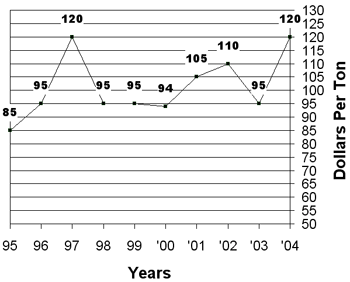Production Update:
Rhizoctonia: Rhizoctonia solani is usually of
minor importance in Arizona, but the fungus can cause severe stand loss
in some situations (
picture).
Rhizoctonia is very versatile and can cause decay of the roots (
picture),
stem, and leaves as well as the crowns. Symptoms usually occur during
the warmer part of the growing season. Circular, concave, black lesions
can appear on taproots but are not always seen in Arizona. Crown decay
appears as dark, rotted areas within the crown tissue. The fungus can
also girdle the stem near the soil line. The disease can cause circular
lesions on the leaves. Control measures include resistant varieties, proper
land leveling, and avoiding over-irrigation. No effective chemical control
measures exist for rhizoctonia.
Insect Management: The granulate cutworm, Agrotis
subterranea, (Fabricius) (picture),
is a devastating pest of bed planted alfalfa and is also an occasional
pest of flood irrigated alfalfa. The cutworm larvae often go undetected
until after cutting or hay removal. When fields are watered back, there
may be areas of little or no regrowth due to cutworms feeding on new shoots
from alfalfa crowns. Granulate cutworm is nocturnal and will move from
cracks in the soil or from under duff in the evening and climb into the
alfalfa canopy to feed. Some of the cutworms feed on new shoots under
the duff, holding back regrowth, depleting starch reserves in the crowns
and thereby weaken the plants. Weakened plants are more susceptible to
disease. Permethrin, cyfluthrin and endosulfan are insecticides that control
this pest. Cutworms feeding under the duff may escape insecticide treatments.
Weed Control: Dodder (
picture)
has become increasingly widespread in some areas of Yuma County. Multiple
applications of Trifluralin will control this parasite prior to emergence.
It cannot be selectively controlled once it has emerged and become attached
to alfalfa.
| Market Summary |
High
|
Low
|
Average
|
Off grade
|
| Past 2 Weeks (2004) |
125
|
110
|
120
|
90-100
|
| Last Year ( 2003) |
98
|
90
|
95
|
80-90
|
10 Year Summary (April 20, to May 3, 1995-2004):

Issued in furtherance of Cooperative Extension work, acts of May 8 and June 30, 1914, in cooperation with the U.S. Department of Agriculture, James A. Christenson, Director Cooperative Extension, College of Agriculture and Life Sciences, The University of Arizona.
The University of Arizona is an equal opportunity, affirmative action institution. The University does not discriminate on the basis of race, color, religion, sex, national origin, age, disability, veteran status, or sexual orientation in its programs and activities.
Any products, services, or organizations that are
mentioned, shown, or indirectly implied in this web document do not imply
endorsement by The University of Arizona.
Information provided by:
Barry Tickes, btickes@ag.arizona.edu Extension Agent, Yuma County
Michael Ottman, mottman@ag.arizona.edu Agronomy Specialist
College of Agriculture, The University of Arizona.
Eric Natwick, etnatwick@ucdavis.edu UCCE Imperial County - Farm Advisor
University of California, Davis, CA.
Forages: Crop Mgmt | Soil Mgmt | Irrigation | Alfalfa Reports | Insects | Diseases | Weeds | Pesticides
Home | Other Crops | Forages
For more Arizona Production Ag Information:
Home | Cotton | Veggies| Forages | Grains | Citrus | Crop x Crop | Insects | Diseases| Weeds | Pesticides | News | Weather | Research | Photos | Contacts | General Info. | Site Map
Copyright © 2001 University of Arizona,
College of Agriculture and Life Sciences
Webmaster: Al Fournier (fournier@ag.arizona.edu)